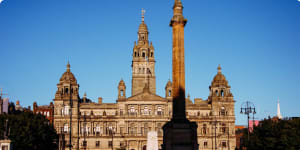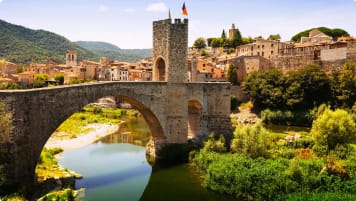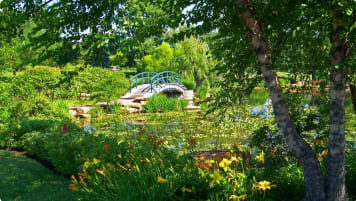Liverpool, Newcastle, Glasgow
From €8,910EUR
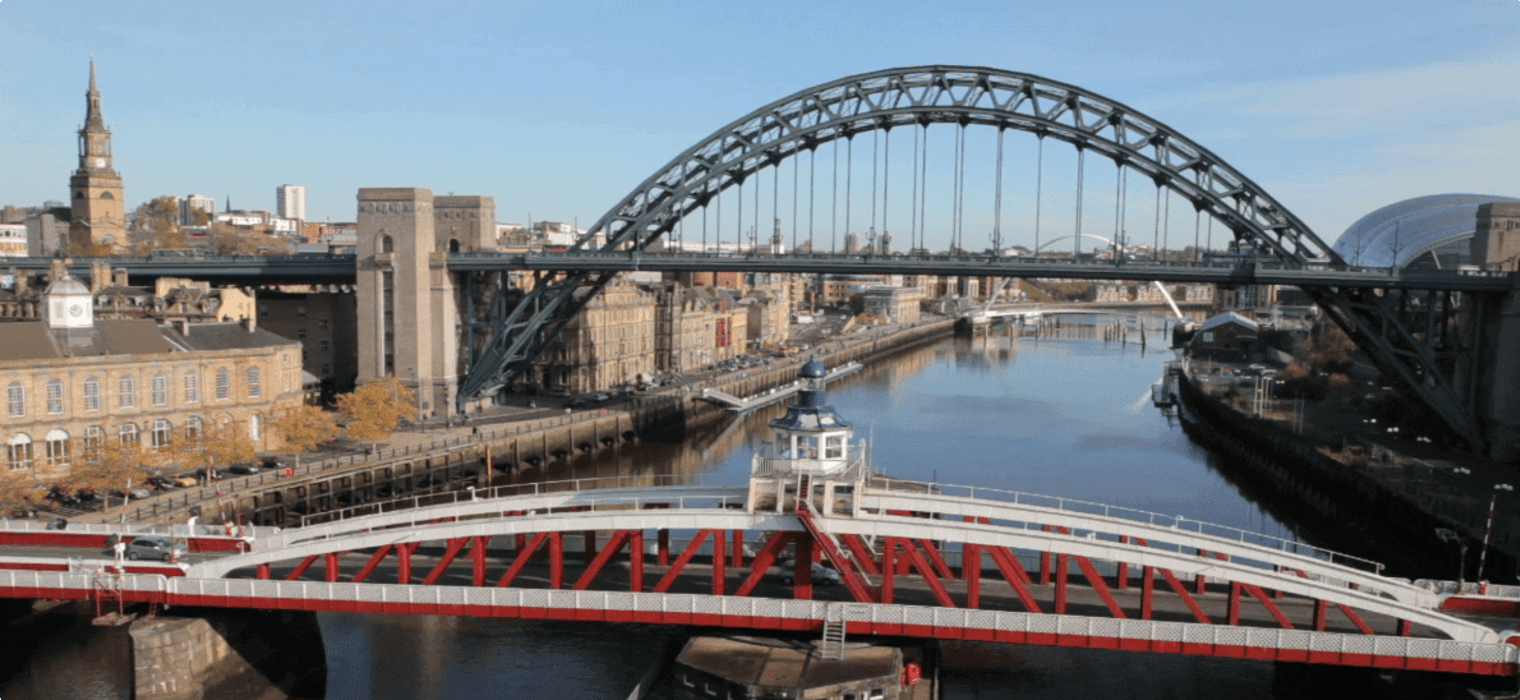
Highlights
- 1. A guided tour of the Hunterian Museum and Art Gallery, Scotland's oldest public museum.
- 2. A journey on Liverpool's famous Mersey Ferry and a trip to the Merseyside Maritime Museum.
- 3. An exploration of Glasgow's shipbuilding heritage in the historic area of Clydebank.
- 4. We visit the Port Sunlight Museum and Garden Village. This century garden village that was created for the Sunlight Soap factory workers!

Departure Dates
| Departure Date | Price |
|---|---|
| 27 June 2025 Ends 17 July 2025 • 21 days €8,910 Twin €10,863 Single Available | Selected |
| 29 August 2025 Ends 18 September 2025 • 21 days €8,910 Twin €10,863 Single Available | |
| 26 June 2026 Ends 16 July 2026 • 21 days €9,642 Twin €11,595 Single Available | |
| 28 August 2026 Ends 17 September 2026 • 21 days €9,642 Twin €11,595 Single Available | |
| 25 June 2027 Ends 15 July 2027 • 21 days €9,642 Twin €11,595 Single Available | |
| 27 August 2027 Ends 16 September 2027 • 21 days €9,642 Twin €11,595 Single Available |
Liverpool-Newcastle-Glasgow Small Group Tour
This is a 22-day small group touring program that explores three great cities of Great Britain in three weeks: Liverpool, Newcastle, and Glasgow. If you are a mature-aged or senior traveller with a thirst for knowledge and an open inquisitive mind, we would love to have you on board for our next departure of our private guided tours. This small group educational program typically spends one week in self-catering apartments in the city centre of these locations, where we will be accompanied by an Odyssey Program Leader and local tour guides to get to our destinations.
Itinerary of the Liverpool-Newcastle-Glasgow Small Group Tour
Liverpool
On our small group tours Liverpool England commences the program, a city with more historic building than any other metropolis outside of London. Liverpool city is home to the most expensive brick and the largest brick building with some 27 million bricks used to build the Tobacco warehouse in 1901. Though Liverpool is not the largest city in Britain, it is certainly colourful with a cosmopolitan vibe reflected in our visits to Levers Brothers creation of Port Sunlight to the Beatles. A very interesting city built around it's port, the history of this city begins here and radiates out. There is unfortunately a dark side as well, the slave trade, which Odyssey Travellers will also learn about.
Newcastle upon Tyne
From Liverpool we travel east across to Newcastle, a Georgian city on the Tyne river. A long history is examined, in this city including its significant role in the Industrial Revolution and coal. The area below what was the Scottish and Newcastle Breweries plant near modern-day St James’ Park football stadium was mined extensively for coal. In the 16th century, coal mined in Newcastle (and shipped to London) surpassed wool as the town’s chief export. London’s dependence on Newcastle coal gave rise to the expression “carrying coals to Newcastle“, which means doing something unnecessary or superfluous. On this tour we will look at the monuments built during this sudden growth of industry. The Georgian architecture created a city of beauty into which the railway lines of the Victorian era arrived into, before going north to Scotland.
Glasgow
Glasgow is Scotland's largest and most populous city, situated along both banks of the River Clyde which discharges to the Atlantic. The River Clyde was an important body of water that gave life to various communities in Glasgow throughout the centuries, including Celtic tribes and the Romans. The city's location--between the Highlands and the Lowlands, between the capital Edinburgh and the west--made it a prosperous centre for trade, and the Acts of Union that united England and Scotland opened the city to the markets of the British Empire. In this city, we take time to look at the work of the Romans, with a visit to the UNESCO World Heritage-listed Bearsden Bathhouse built in 120 AD, and to view the Victorian-era architecture of its great monuments.
Glasgow is a city filled with stories and legends from Charles Rennie Mackintosh to the acquisition of a Salvador Dali painting in Kelvingrove Art Gallery. Whilst these icons headline, we also visit the architectural work of Alexander ‘Greek’ Thompson in the city and out at Holmwood. The program explores the shipyards through to Merchant City, and we learn just why there is a traffic cone permanently on the head of the Duke of Wellington or the story of Nelson Mandela place.
For more details, click the ‘Top 5’ or ‘Itinerary’ buttons above! If you’re keen to experience this tour, please call or send an email. Or, to book, simply fill in the form on the right hand side of this page.
To learn more and to start planning your adventure, you may begin with reading our country profiles on Britain, England, and Scotland. We also regularly publish informative articles connected to our tours, such as about the buildings & places of Glasgow, the industrial revolution and Newcastle upon Tyne.
Gallery

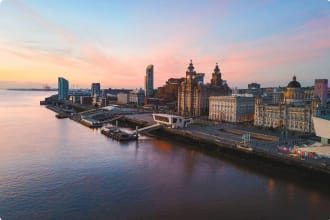
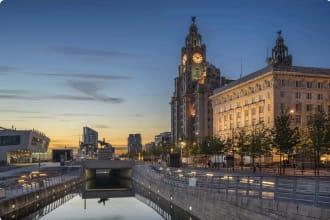
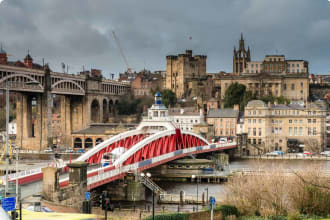
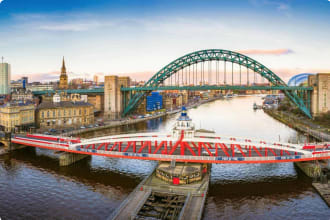

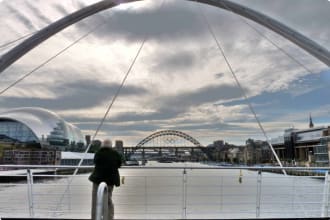
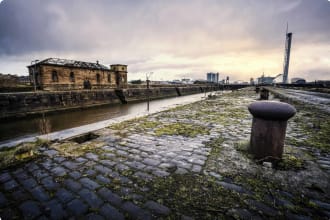
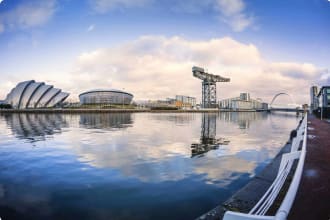
Itinerary
21 days
Day 1: Liverpool
Accommodation: StayCity Aparthotels Duke Street or similar
We arrive at the hotel by our own arrangements. The group comes together for a welcome dinner in the evening.
Day 2: Liverpool
Accommodation: StayCity Aparthotels Duke Street or similar
We begin our first full day with an introductory lecture on the Liverpool’s history and industrial legacy, led by a local speaker/guide. Following this, we embark on a half-day walking tour to orientate in the city and to view the most notable buildings.
These include the Liverpool Cathedral, which is a spectacular building, and the world’s largest Anglican Cathedral. Also, we’ll view the iconic Royal Liver Building, an astonishing waterfront structure on the River Mersey built from 1908-1911 to hold the Royal Liver Group. It is part of UNESCO’s World Heritage designated Maritime Mercantile City area of Liverpool.
After the tour, the remainder of your day is free to relax or further explore the city.
Day 3: Liverpool
Accommodation: StayCity Aparthotels Duke Street or similar
Today we enjoy a full day of sightseeing focusing on the city’s maritime history. There are multiple renowned museums with this theme, including the Merseyside Maritime Museum and the Great Port Gallery, both of which we visit today. And we enjoy a sightseeing cruise on the famous Mersey Ferry.
An on-site guide will also take us on a tour of the Old Dock between museum visits.
Day 4: Liverpool
Accommodation: StayCity Aparthotels Duke Street or similar
Today is a day of self-guided visits to some of Liverpool’s most enlightening cultural institutions.
We begin with a visit to the Walker Art Gallery, which houses an extraordinary collection of art, from classical European painting to excellent contemporary works. Then we visit the Tate Liverpool, renowned for its contemporary exhibitions.
As a city with a history of slave-trading, Liverpool is also home to the International Slavery Museum. Here we will see horrifying and incredible stories that cover the more than 2,000 year history of slavery, along with England’s role in the trade.
Tonight, we have a group dinner at a local restaurant.
Day 5: Liverpool
Accommodation: StayCity Aparthotels Duke Street or similar
Today, we head out from Liverpool for a full day guided excursion to nearby Wirral Peninsula and Port Sunlight. The Wirral Transport Museum is a recently renovated local museum housing many original vehicles from the early 20th century, and we can take a short return journey on the heritage railway.
We’ll also visit the Port Sunlight Museum and Garden Village. This is a quaint and pretty nineteenth century garden village that was created for the Sunlight Soap factory workers! It includes is a walking trail, rotating exhibitions, a tea room, and a gift shop.
Day 6: Liverpool
Accommodation: StayCity Aparthotels Duke Street or similar
Today we enjoy another full day of sightseeing. This includes a guided tour of the Williamson Tunnels. We know that these were built by local philanthropist Joseph Williamson from 1810-1849, but the reason for their existence remains contentious. His claim was that the project’s purpose was simply a project to employ the poor. What we do know is that Joseph Williamson was a notorious eccentric who once released all the bird’s in his wife’s aviary because he could not bear to see them held captive.
We also visit Sudley House, a nearby stately home which was home to a Victorian merchant.
Day 7: Liverpool
Accommodation: StayCity Aparthotels Duke Street or similar
Today is free for you to do as you wish. You might further explore Liverpool, or simply rest and recuperate before we continue on to Newcastle tomorrow. We spend our last evening in Liverpool with a group dinner at a local restaurant.
Day 8: Newcastle
Accommodation: The Vermont Aparthotel or similar
We begin the morning heading to Liverpool station. From there, we take a 3 hour train journey to Newcastle and once we arrive, transfer to our accommodation.
The group will have their introductory lecture on the city’s history and industrial legacy (led by a local speaker/guide) this afternoon after arrival at the hotel.
In the afternoon we attend an introductory lecture during which we learn about the history of Newcastle and it’s industrial past and formative coal mining heritage.
In the evening, we enjoy a group dinner at a local restaurant.
Day 9: Newcastle
Accommodation: The Vermont Aparthotel or similar
On our first full day in Newcastle, we spend the morning taking a half-day tour of the city’s main sights. We view Grey’s Monument, an impressive monument to Charles Grey, built in 1838. We also see the Tyne Bridge and Swing Bridge, both architecturally impressive feats of engineering. The afternoon is free at your leisure.
Day 10: Newcastle
Accommodation: The Vermont Aparthotel or similar
Today we enjoy a full day of sightseeing, spending time at museums and institutes with the them of the region’s industrial history. Our first destination is the Discovery Museum, which has the world’s first steam-turbine-powered steamship, the Turbinia, as well as many exhibits on local history – such as the Destination Tyneside exhibition.
We then tour the North of England Institute of Mining and Mechanical Engineers (NEIMME), more commonly known as The Mining Institute, which possesses one of the largest collections of mining information in the world. We then head to the Literary and Philosophical Society of Newcastle upon Tyne (known as The Lit & Phil), which is a must-visit museum and library for any book lovers, established 225 years ago.
Finally, we visit The Great North Museum: Hancock, which houses an exhibition on Roman settlement in the area and on Hadrian’s Wall.
Day 11: Newcastle
Accommodation: The Vermont Aparthotel or similar
We spend the first half of today in Newcastle’s Quayside area. First, we visit the Baltic Centre for Contemporary Art, which is, strikingly, a converted flour mill positioned on the riverside. Very active in its original form, it reopened as a gallery in 2002.
We then take a guided tour of the Victoria Tunnel, which was a subterranean wagonway designed to transport coal from a local colliery down to the boats for exporting. In the afternoon, we can take the Metro to visit the George Stephenson Railway Museum in North Shields.
In the evening, we enjoy dinner together at a local restaurant.
Day 12: Newcastle
Accommodation: The Vermont Aparthotel or similar
Today we venture beyond Newcastle.
First, we travel to Woodhorn where we visit the Woodhorn Museum. Woodhorn is a village in Northumberland with a history of coal mining and that history is documented by the museum, showcasing original equipment and buildings and telling the stories of how workers survived.
We then head to Cragside to see Cragside Estate, which holds a place in history for being the first house in the world to be lit by hydroelectric power.
Then, to Bamburgh to see Bamburgh Castle, built in the 11th century and looming over the local village. We return to Newcastle in the evening.
Day 13: Newcastle
Accommodation: The Vermont Aparthotel or similar
Again, today, we spend the day exploring out of Newcastle.
We begin by travelling to Shildon where we’ll visit The National Railway Museum. It’s home to many locomotives from the National Collection, including the original ‘Sans Pareil’ a steam locomotive built by Timothy Hackworth in 1829 and tested out on the Liverpool-Manchester Railway.
Then we head from Shildon to Killhope where we’ll visit The North of England Lead Mining Museum. This museum is on the site of a former working lead mine, set within the scenic North Pennines AONB.
From here, we will head to Once Brewed, a village in Northumberland that is only a few miles from Housesteads Fort. We travel to the Fort, which is a stunning part of Hadrian’s Wall’s remains.
Day 14: Glasgow
Accommodation: Fraser Suites studio apartments or similar
Today we head from Newcastle to Glasgow. In the morning, we board a coach to transfer to Newcastle train station, where we take a train for the 2.5 hour journey to Glasgow. On arrival we transfer to the hotel. Once there, we attend an afternoon lecture during which we’ll learn about the city’s past, and particularly its ship-building heritage.
Day 15: Glasgow
Accommodation: Fraser Suites studio apartments or similar
On our first full day in Glasgow we begin with a half-day introductory city walking tour. We visit George Square and also take a guided tour of the magnificent Glasgow City Chambers.
Then we indulge in afternoon tea at the delightful Cup Tea Lounge, a tea room with a Victorian interior. The remainder of the day is free to do what you will.
Day 16: Glasgow
Accommodation: Fraser Suites studio apartments or similar
This morning, we undertake a half-day guided tour of Merchant City, during which we view the Tolbooth Steeple, Hutchesons’ Hall, and Central Train station. We also learn about Glasgow’s role in the slave trade throughout history, before visiting the Gallery of Modern Art.
The remainder of the day is free, before we come together for dinner at a local restaurant.
Day 17: Glasgow
Accommodation: Fraser Suites studio apartments or similar
Today will begin with a tour of the Cloisters at the University of Glasgow. We then visit the Hunterian Museum and Art Gallery where we are given a guided tour. This is Scotland’s oldest public museum, and has a very impressive collection of art and objects of antiquity.
We then take a walking tour, during which we visit a number of museums galleries and libraries, including the Kelvingrove Museum and Art Gallery, Dali’s ‘Christ of St John of the Cross’ Museum, and the Mitchell Library.
Day 18: Glasgow
Accommodation: Fraser Suites studio apartments or similar
Today we begin by exploring Holmwood House, the most elaborate villa designed by Scottish architect Alexander Thomson. Completed in 1858, it is a glorious example of the Greek Revival style. We also get to enter the oddly named House for an Art Lover a combination art gallery and exhibition space in a traditional stately home. We then see The Lighthouse, which is Scotland’s Centre for Design and Architecture. This is a wonderful building in Central Glasgow that holds all sorts of exhibitions and events.
Day 19: Glasgow
Accommodation: Fraser Suites studio apartments or similar
Today is a full day focusing on Glasgow’s shipbuilding heritage, with a focus on the area of Clydebank. We take guided tours of both the Tall Ship and the Titan Crane. We will learn all about Glasgow’s maritime history at the Riverbank Museum of Transport and Travel.
Day 20: Glasgow
Accommodation: Fraser Suites studio apartments or similar
Today is our final full day of the tour! We take advantage of our location in Glasgow by travelling to some nearby sites. We take a coach to New Lanark, where we enter the New Lanark Heritage Site. We then travel to Falkirk where we take a wheel boat cruise. And finally travel to Stirling to see the famed Stirling Castle, one of Scotland’s largest castles.
We return to Glasgow and have a farewell dinner in a local restaurant.
Day 21: Glasgow
This is the final day of the tour, and in the morning, we make our own way to the airport.
Includes / Excludes
What’s included in our Tour
- 20 nights hotel accommodation.
- 20 breakfasts and 9 dinners.
- Guided tours and entrances as per itinerary.
- Transport by coach.
- Tipping and gratuities.
- Odyssey Program Leader.
- Detailed Preparatory Information.
What’s not included in our Tour
- Return international airfares and departure taxes.
- Comprehensive travel insurance.
- Items of personal nature such as laundry and phone calls.
Participants must be able to carry their own luggage, climb and descend stairs, be in good health, mobile and able to participate in 3-5 hours of physical activity per day, the equivalent of walking / hiking up to 8 kilometers per day on uneven ground.
Book now
Make it a private tour
Easing your journey
Crossing international borders with restrictions
The list of requirements to travel internationally has changed and will continue to change for several years. Odyssey is here to assist you in managing your way through these requirements:
For more information see our Crossing international borders with restrictions page.
Book With Confidence
If less than 30 days before your tour starts you are unable to travel as a result of Government travel restrictions, Odyssey Traveller will assist you with a date change, provide you with a credit or process a refund for your booking less any non-recoverable costs.
See Terms and conditions for details.
Peace of Mind Travel
The safety of our travellers, tour leader, local guide and support staff has always been our top priority and with the new guidelines for public health and safety for keeping safe for destinations around the world, we’ve developed our plan to give you peace of mind when travelling with us.
See Peace of Mind Travel for details.
Reading List Download PDF
Iron, Steam & Money: The Making of the Industrial Revolution
Roger Osborne
In late eighteenth-century Britain a handful of men brought about the greatest transformation in human history. Inventors, industrialists and entrepreneurs ushered in the age of powered machinery and the factory, and thereby changed the whole of human society, bringing into being new methods of social and economic organisation, new social classes, and new political forces. The Industrial Revolution also dramatically altered humanity's relation to the natural world and embedded the belief that change, not stasis, is the necessary backdrop for human existence.
Iron, Steam and Money tells the thrilling story of those few decades, the moments of inspiration, the rivalries, skulduggery and death threats, and the tireless perseverance of the visionaries who made it all happen. Richard Arkwright, James Watt, Richard Trevithick and Josiah Wedgwood are among the giants whose achievements and tragedies fill these pages. In this authoritative study Roger Osborne also shows how and why the revolution happened, revealing pre-industrial Britain as a surprisingly affluent society, with wealth spread widely through the population, and with craft industries in every town, village and front parlour. The combination of disposable income, widespread demand for industrial goods, and a generation of time-served artisans created the unique conditions that propelled humanity into the modern world.
The industrial revolution was arguably the most important episode in modern human history; Iron, Steam and Money reminds us of its central role, while showing the extraordinary excitement of those tumultuous decades.
Walking Through Glasgow's Industrial Past (Walk With Luath)
Ian R Mitchell
Walking Through Glasgow's Industrial Past sets out to retrieve the hidden architectural, cultural and historical riches of some of Glasgows working-class districts. Many who enjoy the fruits of Glasgows recent gentrification may be surprised and delighted by the gems which Ian Mitchell has uncovered beyond the usual haunts.
Complete with maps of the areas covered, and illustrations and photographs of Glasgow s industrial past, this guide presents the social history of a city.
Britain's Industrial Revolution: The Making of a Manufacturing People, 1700 - 1870
Barrie Trinder
Barrie Trinder has been a leading expert on industrial history for many years and this is perhaps his most important book to date: a general overview of the industrial revolution across the British Isles. The industrial revolution was one of the defining changes of human history, and it happened in Britain first. It changed radically the way in which goods were made: for the first time large factories were built to house the machines and power systems that had been invented. It led to new ways of working, and living: it concentrated workers in large workplaces, often in the rapidly growing towns and cities. Along with spectacular profits and economic benefits, it brought danger, pollution and increasing inequality between rich and poor. Alongside industry arrived canals, railways, cast-iron bridges and iron ships. The industrial revolution created the country and the society we recognise today.
The Industrial Revolution Explained: Steam, Sparks & Massive Wheels
Stan Yorke
The English Industrial Revolution was a triumph of ingenuity and invention. New sources of power, better manufacturing methods and expanding transport systems brought fantastic changes affecting every walk of life. Man and machine worked side by side to produce iron, coal and cotton cloth on a scale never before imagined.
In this easy-to-follow and carefully researched book, Stan Yorke explains the machines and processes that helped to create our industrial world, using drawings and diagrams by his son, Trevor. Four major industrial areas are examined: the waterwheel as a source of power in mills and foundries; the steam engine which made power available to a variety of manufacturing industries; the mechanisation of textile production making cloth for all a reality; and iron, which revolutionised bridge construction and made the railways possible.
Liverpool: A People's History
Peter Aughton
This book traces the growth of the city from a little fishing village on the banks of the Mersey all the way from its foundation in 1207 to the proud European Capital of Culture 800 years later. Combining good historical research with a lively, fresh and highly accessible style, Peter Aughton describes every stage of Liverpool’s remarkable town, its unprecedented growth as the major seaport for the world’s first industrial society, its role in a mass history: from its origins as a tiny port in the tidal inlet known as the ‘Liver Pool’, to the horrors of the slave trade, the building of the world’s first ever public railway, its brief spell in the eighteenth century as a fashionable spa emigration movement that saw perhaps as many as nine million souls depart from its quaysides for a better life in the New World, the devastation to docks, public buildings and houses caused during the terrible Blitz in 1941, the Mersey Sound which now draws thousands of visitors from around the world, right up to the recent renaissance of the town’s fortunes which has culminated in the European Capital of Culture bid success.
